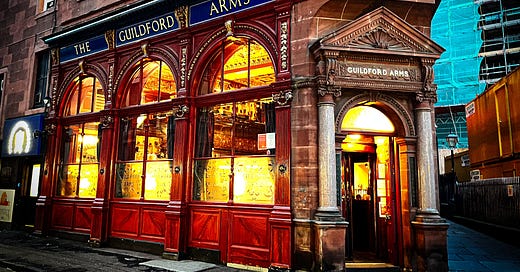This is part three of an occasional series on my favourite pubs near Edinburgh’s train stations. Check out my previous reviews of Ryrie’s by Haymarket and The Doric Tavern by Waverley.
The Stewart family have the pubs-by-the-station market tied up. By Haymarket, they have Ryrie’s, a solid pub with a commitment to good ale. And just off Prince’s Street, they have the grand Guildford Arms, another real ale haven and the perfect place for a pre-Waverley pint.
Owners DM Stewart also have two other pubs in their stable: The New Town neighbourhood spot The Cumberland Bar and the centrally located Abbotsford, on Rose Street. The Guildford Arms combines the qualities of all its sister pubs in the best possible way.
It has the heavy red curtains and snug nooks of The Cumberland. It takes the classic-with-a-modern-twist decor from Ryrie’s. And with The Abbotsford, it shares the same city-centre buzz.
In fact, The Guildford Arms is the original pub in the DM Stewart roster, having been owned by the same family since it opened in 1896. The pub’s own website claims it owes its lavish design (don’t forget to look up at the opulent ceiling) to the temperance movement, which was in full flow in the 19th century. Presumably, publicans had to offer something more than a dark room and a couple of bottles of booze if they wanted to get a licence from the austere authorities of the time. I wonder if the rotating doors might have been enough of an obstacle to keep out some of the more legless folk out too.
The pub shares some similar features to other turn of the century institutions such as The Diggers – or The Artisan Bar, another pub linked to the temperance movement. All three have imposing dark wooden bars, beautiful mirrored gantries, high ceilings, and crucially, good beer. (Though The Guildford seems to be lacking a bit in its whisky selection.)
I am here late on bank holiday Monday and it’s still busy, with the relaxed atmosphere of a final drink before work tomorrow. I’m delighted to see that a majority of the 10 cask ales on offer are Scottish, and I know from experience in all the sister pubs that the owners take care of their beers. I opt for an organic rye IPA from Musselburgh’s Newt Brew. It looks thick as soup in the glass, but is actually pleasantly light in taste, without the overbearing drymouth hoppiness you often get from hazy IPAs.
As I survey the pleasing details in the pub’s interior, I feel happy that this place is here. Many pubs in such a central location wouldn’t pay this much attention to detail, or bother keeping 10 cask ales on top of at least a dozen other beers on keg. It’s nice to see that the owners care about preserving historical places like this, without making it exclusive or prohibitively expensive. It’s perfectly pitched: Café Royal for the everyman; Spoons for the more discerning drinker. We’re lucky to have it.
Where is it?
Where next?
You could cross St Andrew’s square to The Abbotsford, or head straight through Waverley to The Doric Tavern.
The chaser
Mainstream beer had become something you bought on price, by the slab, from the supermarket. But within a few years, beer was cool again. It was new and exciting. It captured the public imagination. Its cultural value – which had always been there – was finally recognised.
I’d recommend this piece by Pete Brown if you are, or ever were, into good beer. It’s a look back at the craft beer heyday of a decade ago, wonders how it lost its way, and reminds us why we loved it in the first place. And it provides a rallying call: Let’s Make Craft beer Great Again.





